Only 27% of small-business buyers purchase software that meets or exceeds their expectations without compromises. Use these proven practices that lead to software selection success.

When it's time to purchase software for your small business, the path to success seems crystal clear: Identify a problem, then find software that best solves that problem within your budget. Under these simple circumstances, every software purchase should be a winner, right?
But throw in obstacles such as shifting budgets and priorities, disengaged stakeholders, tight deadlines, and competing information from an overwhelming number of sources, and this once-clear path to success becomes a lot more uncertain.
As a small-business owner or leader, you know failure isn’t an option. We couldn’t agree more. With little room for costly errors, every software purchase needs to be a home run. That’s why we surveyed small-business leaders about their process for selecting software, and identified five tactics that can increase your odds of a successful software purchase.
Think of these five tactics as guiding lights that can illuminate your path to success, and give you confidence in your ultimate purchase decision. If you’re ready, read on to learn the formula for finding great software for your needs.
How hard is it to get a Great Match on business software?
With so many obstacles in the way, and an increasing number of software options to choose from, finding software that emphatically checks all of your boxes is not guaranteed if you’re a small business.
Far from it, in fact. In a Capterra survey of 1,000 small-business leaders who have influence on software purchase decisions, only 27% managed to secure what we call a “Great Match” on the last software purchase for their organization (click here for our methodology for determining a Great Match):
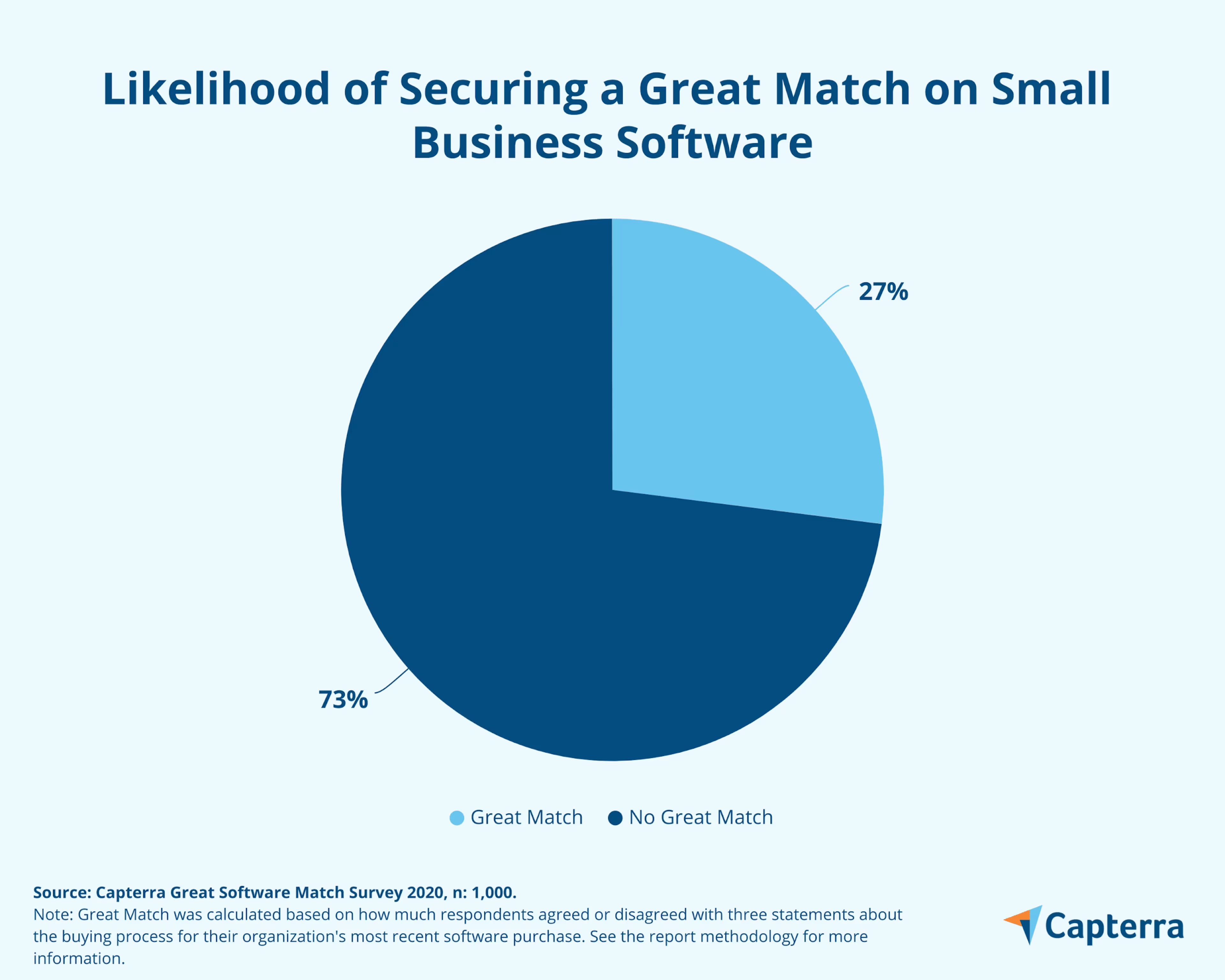
In other words, only around one in four small-business software purchases result in a Great Match: a deal that meets or exceeds expectations without compromises.
That’s it! The rest either compromise on their original vision, or purchase software that fails to meet expectations—leading to further problems, additional software purchases, or, in the worst cases, purchase regret that forces small businesses to start over.
So, how do you become one of the few that succeeds instead of the many that fail? The answers lie in the five tactics we’ve listed below.
These tactics can be implemented at any small business, regardless of what software you’re purchasing or your technical know-how, and can improve your likelihood of selecting software that satisfies all of your needs. Let’s get started.
Tactic #1: Focus on internal goals instead of external pressures
As part of Capterra’s Top Technology Trends Survey 2020, we asked small-business software buyers to select the top three factors that triggered their investment in new technology. The results show that the decision to purchase software can come from a variety of different motivations:
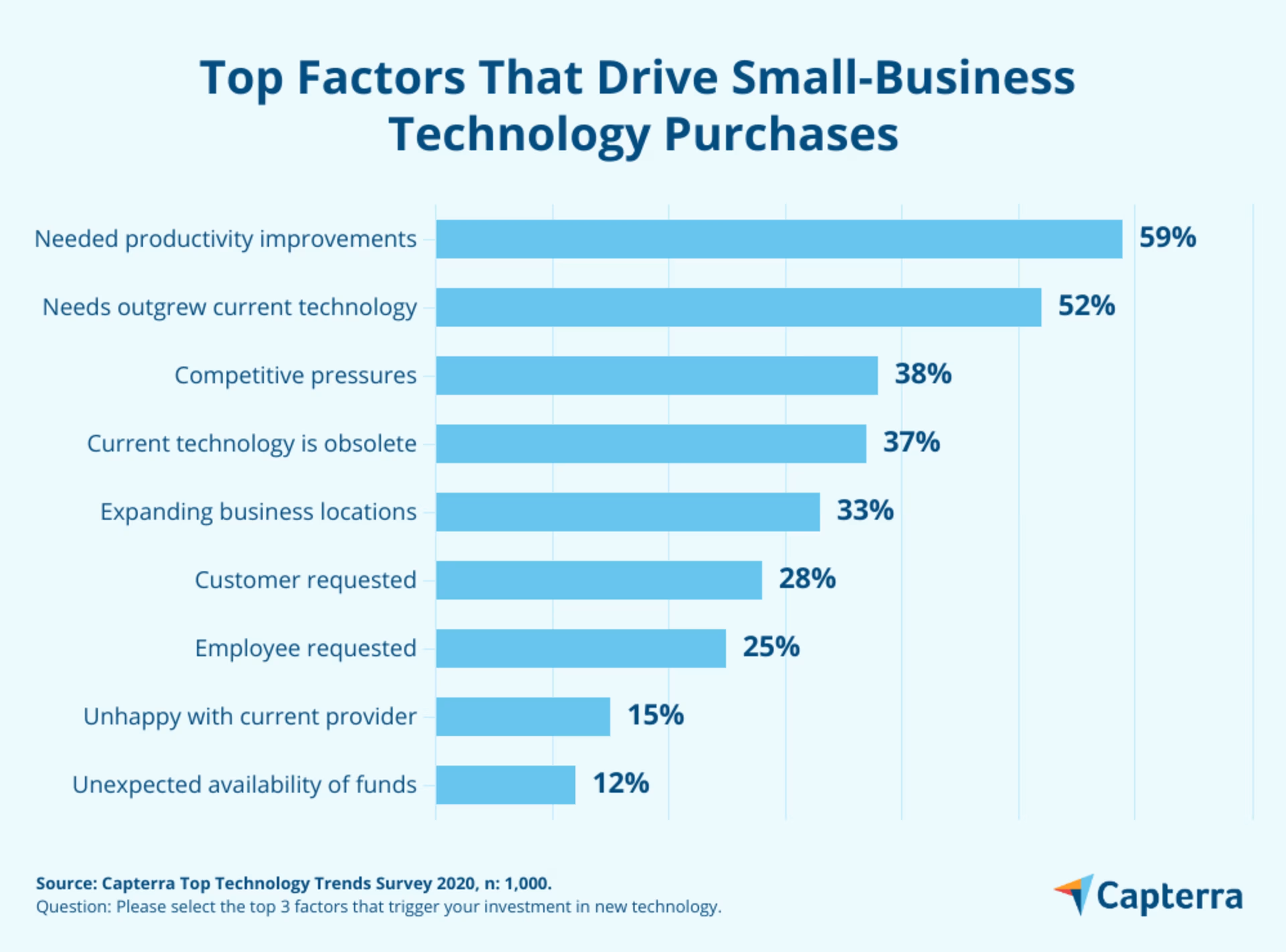
You probably recognize your own motivation for purchasing software from this list. And it’s this motivation—your reason for purchasing software in the first place—where problems can start to happen.
Specifically, we found that when businesses focus on an internal motivation with their software purchase, such as increasing productivity or efficiency, their chances of getting a Great Match are above average. On the other hand, when they focus on an external motivation such as competitive pressures, Great Match likelihood takes a nosedive.
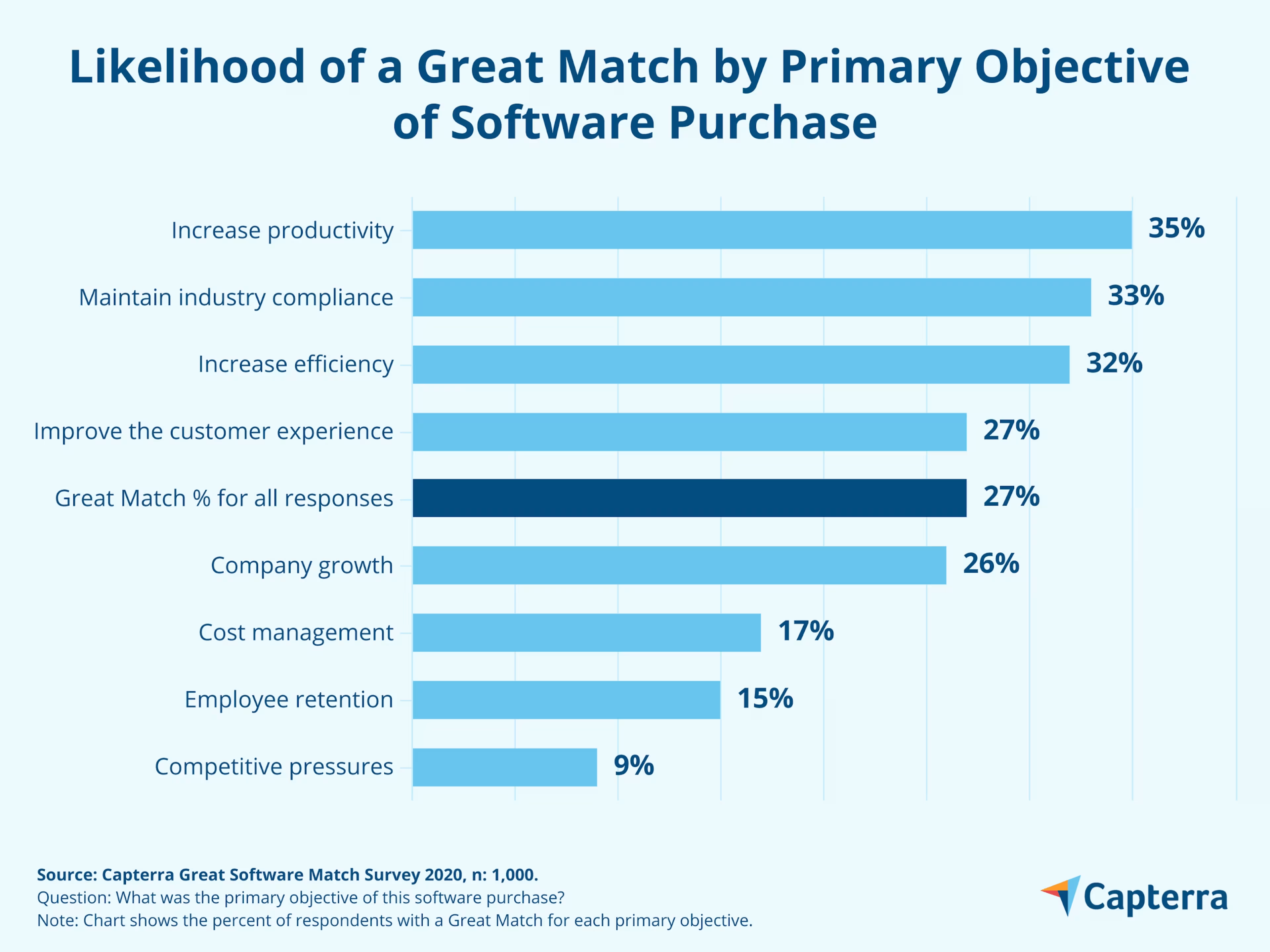
Despite being the third most common factor driving small-business technology purchases, competitive pressures produce Great Matches only 9% of the time.
The reason why is simple: Bowing to competitive pressures leads to bad-faith software investments with poorly defined goals. Without a metric such as productivity or efficiency to accurately gauge success, and without considering if a certain software investment makes sense for your unique business situation, the likelihood of purchase regret is high.
Your next steps
Every software purchase should align with the goals of your small business—regardless of what the competition is doing. Here’s how you can hone in on a specific internal goal that a software purchase can help you achieve:
Look at key performance indicators (KPIs) such as revenue, costs, or productivity and identify where your business isn’t performing up to expectations.
Work with other business leaders to find the underlying causes for why you aren’t hitting a specific KPI. If revenue is low, for example, you may not be reaching enough customers.
Turn that problem (not reaching enough customers) into a specific goal (we need to reach 15% more customers with our social media marketing efforts), then hone in on software products with functionality that can help you achieve that goal.
Tactic #2: Encourage decision-influencers to fully participate
It’s true: The people on your software purchase team have a significant impact on purchase success. But maybe not in the way you would imagine.
For example, you might assume that certain roles or departments need to be involved. We found that’s not the case. Whether selection teams include members from IT, HR, or corporate leadership, it has no significant impact on the likelihood of securing a Great Match.
Instead, what we found is that the level of participation and influence of each member of the software purchase team is much more important. Let’s look at each factor separately.
Avoid occasional participants who can’t fully commit
We asked respondents how many active participants (people included in all or most discussions related to purchasing software) and occasional participants (people not involved in regular discussions that only “drop in” from time to time) were involved in software purchase decisions. We found that those with no occasional participants had better odds of securing a Great Match on software.

Gartner explains why occasional participants can hinder software buying efforts (full research available to Gartner clients):
“Occasional participants will often not have the full context of all the discussions that have occurred with members of the buying team. As a result, they’ll either add limited value to the process, or they may bring biased viewpoints that devalue the work of the project team.”
Wherever possible, encourage active participation from all members of your software selection team. Reschedule meetings and demos as needed to include everyone, and remove members that can’t fully commit to the process.
Reduce the number of members that don’t have decision influence
We also asked how software selection teams broke down between decision-makers, decision-influencers, and those with no decision influence.
What we found is that the fewer participants with no decision influence, the better the result. In our survey, respondents who secured a Great Match averaged one fewer member with no decision influence on their team compared to those without a Great Match.

This difference may seem small (one person!), but with zero sway on the final purchase decision, every extra member on your team that doesn’t have decision influence will muddy the selection process and make it harder to reach a consensus.
Your next steps
Our research shows that when software purchase teams cut the fat—members who aren’t actively involved or have no decision influence—good results happen. Here’s how to put together a lean, mean software purchasing team:
Give potential team members a timeline for the purchase decision and ask if they can fully commit to important dates. If they can’t commit, consider limiting their role or not including them entirely.
Use the DACI/RACI model early on in the process to designate who approves decisions, who influences them, and who merely needs to be in-the-know. (If you’re unfamiliar with this model, learn more about it in “3 Must-Do Things to Ace Your Software Implementation.)
If it’s a toss-up whether to include someone or not, opt to exclude them. Ultimately, the fewer people, the better. (Ever hear of too many cooks in the kitchen?)
Tactic #3: Validate information through independent sources
As you and your team start researching different software options, you’ll quickly discover that information from software vendors is everywhere. Find a demo video, and the vendor probably produced it. Try to determine if a product has a certain feature or not, and the vendor’s website will probably be the first result in your Google search.
Both Great Match and non-Great Match buyers in our survey relied on vendor-provided information during their research. This information is important and, frankly, unavoidable. What separates Great Match buyers, though, is that they take the additional step to validate what they learn through independent sources.
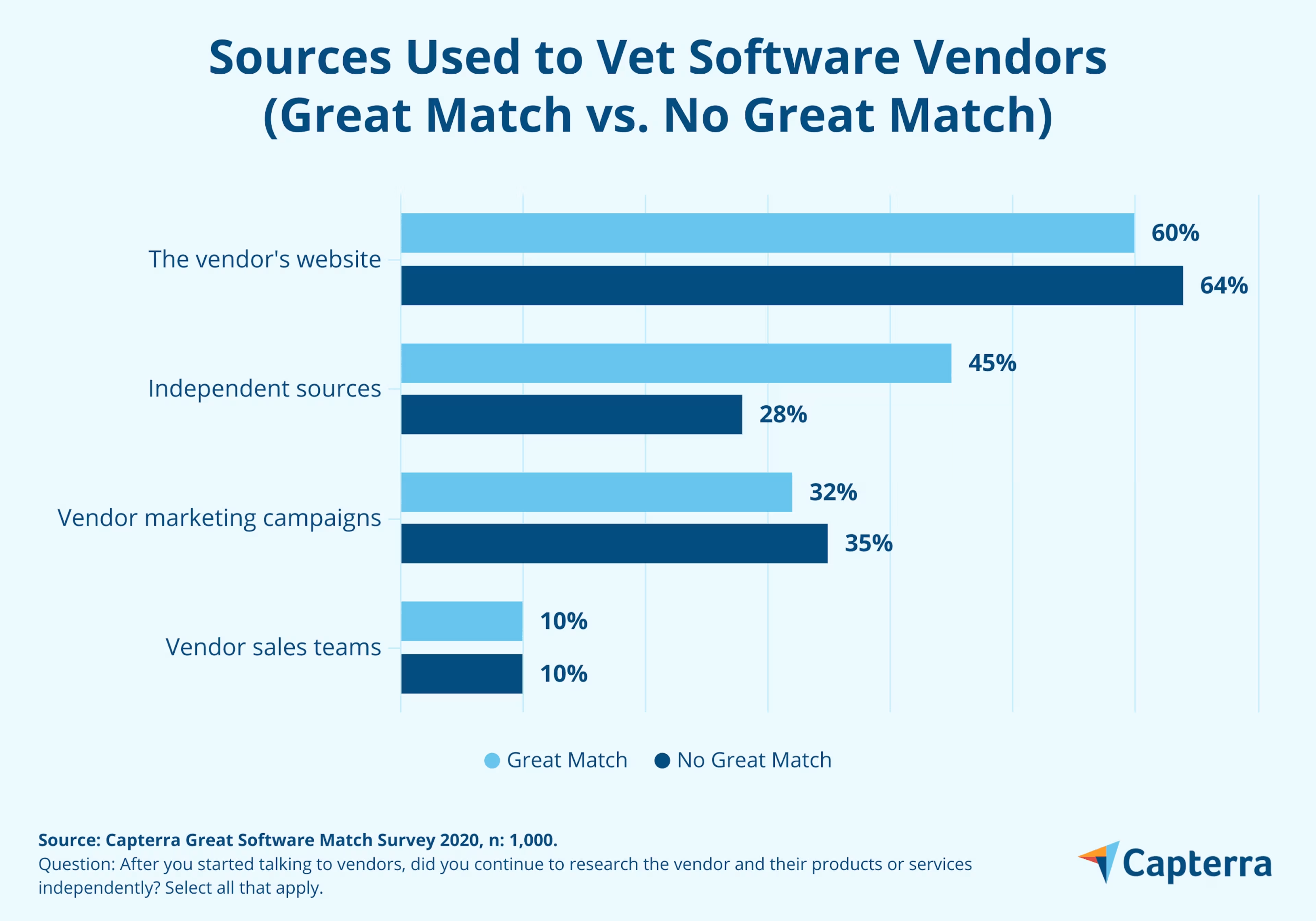
According to our findings, Great Match and non-Great Match buyers are nearly identical in which sources they use to vet software vendors. The only difference is that Great Match buyers are nearly twice as likely to also use independent sources such as user reviews, third-party experts, and peers.
Vetting vendors through these independent sources can help ensure that your team is getting reliable and accurate information—information that isn’t biased towards getting you to sign on the dotted line. If a vendor guides you towards independent information (instead of steering you away from it), it’s also a good sign that they’re confident that the quality of their product speaks for itself.
Your next steps
Capterra has a number of independent data resources that can help you and your team hone in on the best software options for your needs, free from vendor influence. Here are a few examples (we've used CRM software, but this information applies to any software category):
Click on any product on our site to read detailed reviews from real users like you. Learn how to get the most value out of software reviews with “4 Tips on Using Business Software Reviews to Find the Right Product.”
Our comparison tool allows you to compare up to four products at once to see how they stack up against each other in terms of price, features, and user ratings. You can also view popular comparisons that other users have made.
Every major software category on Capterra has our Top 20 report, which uses search engine data and user ratings to determine the 20 most popular products. This is a great place to start if you don’t have any specific products in mind.
Tactic #4: Take advantage of free trial periods
You can read and watch and digest all of the software research out there, but ultimately, nothing beats sitting down and actually trying the software for yourself.
The free trial period that most vendors offer is an invaluable tool for assessing your options and making better decisions. Our research supports this: Buyers who rank free trial periods as the most important source of information to deeply assess software vendors are most likely to secure a Great Match.
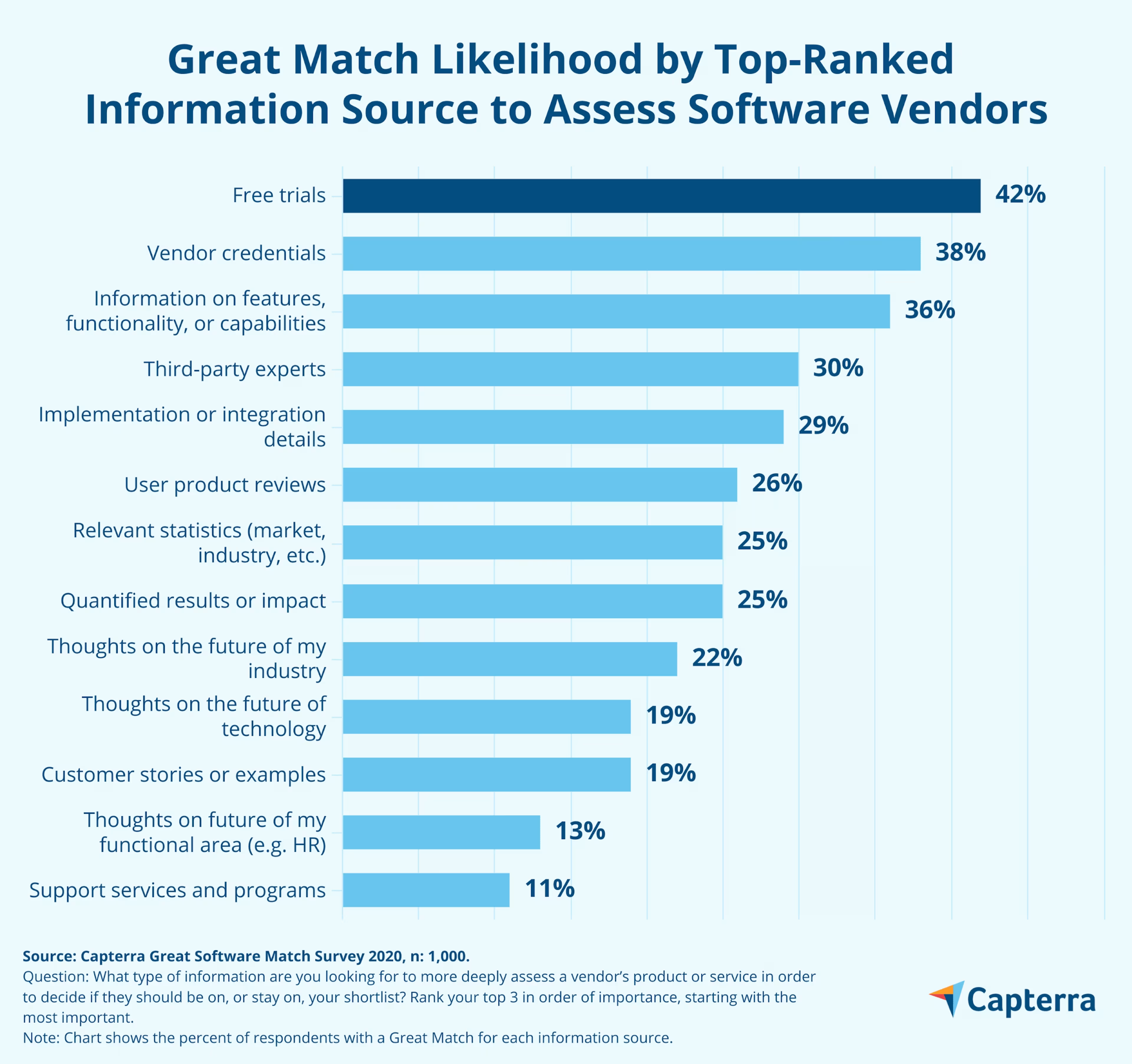
That’s not all. When respondents said free trials most often sparked their interest in a product, or were the biggest help in making a case to include a product on their shortlist, it led to similar Great Match success (42% and 41%, respectively).
Besides giving your team an opportunity to get hands on and learn how user-friendly a system is, free trials are also one of the only ways you can stress test software in a situation unique to your small business. You can test out workflows and identify process gaps to see how the software performs in the exact scenario you plan to use it.
In short, there’s no better way to assess your software options. Use those free trials, people!
Your next steps
As soon as your free trial period starts, the clock starts ticking towards its end. Here’s how to get the most value out of the time you have with free trials:
Dedicate actual time on your calendar to diving into the software and testing it out. If you treat your free trial period as an “if I can get to it” activity, you never will.
Have different types of users (administrators, IT personnel, rank-and-file workers) try out the software to identify pros and cons from their vantage point.
Collect user feedback after they’ve had some time with the software to come up with follow-up questions and make decisions. For more help with this, we encourage you to read “3 Ways to Collect Feedback on Your Software Search.”
Tactic #5: Resist revisiting your shortlist
After researching and discussing software options that look promising, you and your team will pare those options down to a shortlist of vendors worth deeper consideration.
There’s a temptation to fiddle with your shortlist after it’s been finalized. Our research is clear: Don’t do it. We found that the more often you revisit your shortlist to add additional vendors, the less likely you’ll get a Great Match.
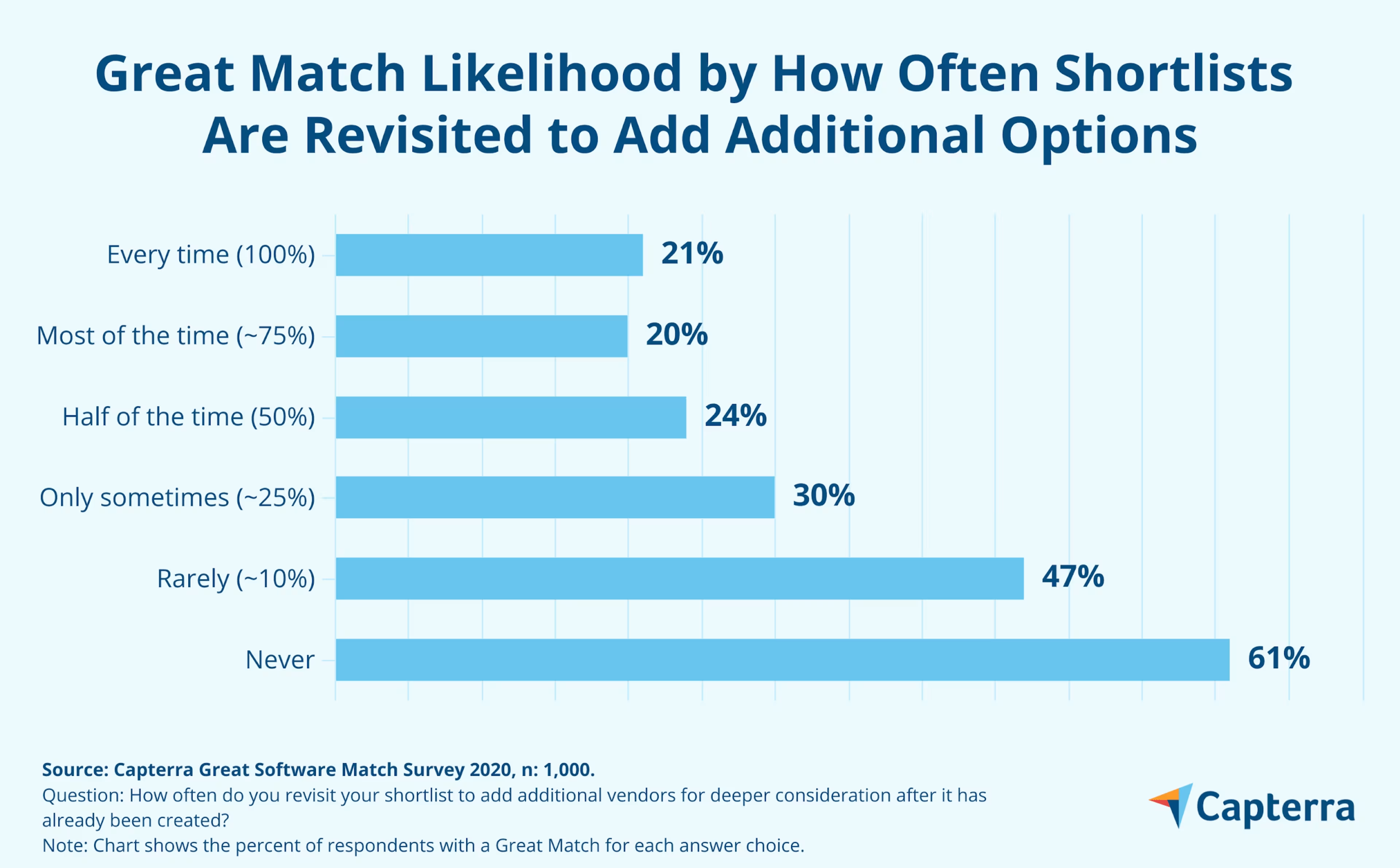
You may think you're being thorough by revisiting your shortlist, but you're really just being indecisive.
Not only does constantly adding options to your shortlist delay the entire process and give your team more vendors to evaluate, it also casts doubt on your initial shortlist in the first place. If you’re so tempted to add those other vendors, did you ever really arrive at your best options?
Those that rarely or never revisit their shortlist can do so because they’ve been thorough in their research, and have built enough confidence and consensus in their shortlist that they aren’t tempted to change it. That’s your goal.
Your next steps
A lack of confidence comes from a lack of clarity. Here’s how you can be certain you’re including the right products on your shortlist:
If two sources of information on a product contradict each other, seek out more sources. User reviews, vendor materials, and third-party experts can all help clarify the situation and give your team a clearer picture of the real answer.
Never hesitate to simply reach out to vendors and ask. If you’re unsure if a vendor offers a certain feature or supports a certain integration, contact them and find out for sure.
If you’re still stuck on which vendors to include on your shortlist, create a vendor scorecard to grade and rank them. Using our template, you can have your decision in as little as 15 minutes.
Average software produces average results
Today, small businesses increasingly rely on software to operate and function. Software is as much a cornerstone in the success of your company as your employees or the products and services you sell.
Settling on new software that’s just OK won’t drive success. That’s why you need a software selection process that gets you the best product for your needs every time. The five tactics we’ve covered here will help you do just that:
Focus on internal goals instead of external pressures
Encourage active participation from decision influencers
Validate information through independent sources
Take advantage of free trial periods
Resist revisiting your shortlist
For more tips on how to become a software buying expert, check out our "Software Buying Tips" blog. Learn how to turn a software vendor into a software partner, for example, or what hidden costs are really rolled into that software price tag.
Then, if you’re ready to start comparing software options, head to our home page to search, compare, and choose the right software with confidence. Buying software can be hard, but it doesn’t have to be.